YAMAHA XMAX 250 2008 Manual PDF
Manufacturer: YAMAHA, Model Year: 2008, Model line: XMAX 250, Model: YAMAHA XMAX 250 2008Pages: 88, PDF Size: 2.76 MB
Page 71 of 88
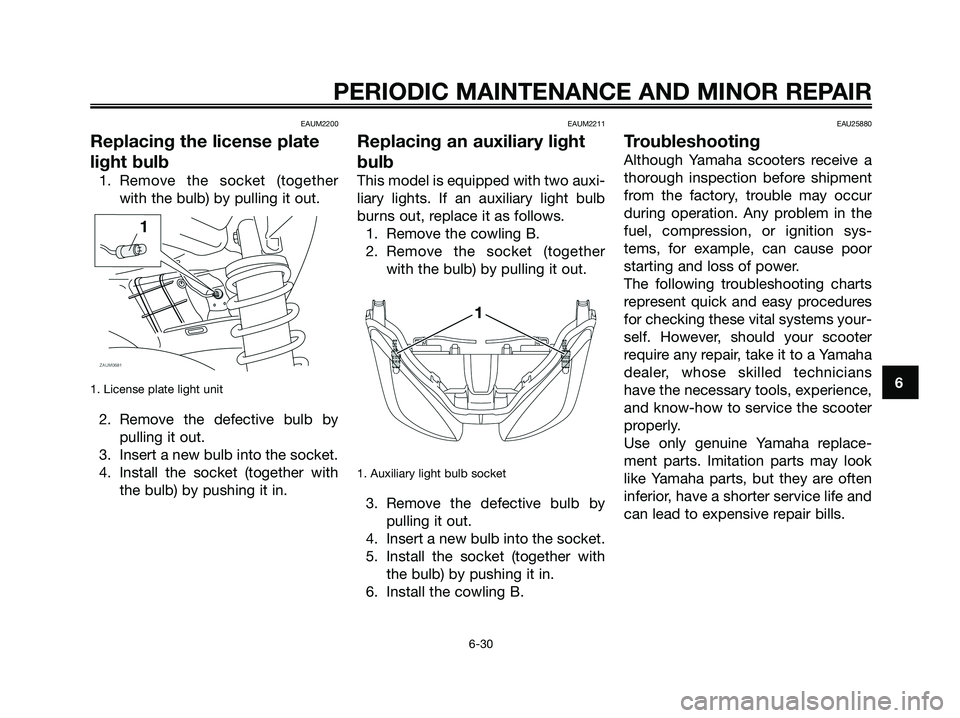
EAUM2200
Replacing the license plate
light bulb
1. Remove the socket (together
with the bulb) by pulling it out.
1. License plate light unit
2. Remove the defective bulb by
pulling it out.
3. Insert a new bulb into the socket.
4. Install the socket (together with
the bulb) by pushing it in.
EAUM2211
Replacing an auxiliary light
bulb
This model is equipped with two auxi-
liary lights. If an auxiliary light bulb
burns out, replace it as follows.
1. Remove the cowling B.
2. Remove the socket (together
with the bulb) by pulling it out.
1. Auxiliary light bulb socket
3. Remove the defective bulb by
pulling it out.
4. Insert a new bulb into the socket.
5. Install the socket (together with
the bulb) by pushing it in.
6. Install the cowling B.
EAU25880
Troubleshooting
Although Yamaha scooters receive a
thorough inspection before shipment
from the factory, trouble may occur
during operation. Any problem in the
fuel, compression, or ignition sys-
tems, for example, can cause poor
starting and loss of power.
The following troubleshooting charts
represent quick and easy procedures
for checking these vital systems your-
self. However, should your scooter
require any repair, take it to a Yamaha
dealer, whose skilled technicians
have the necessary tools, experience,
and know-how to service the scooter
properly.
Use only genuine Yamaha replace-
ment parts. Imitation parts may look
like Yamaha parts, but they are often
inferior, have a shorter service life and
can lead to expensive repair bills.
PERIODIC MAINTENANCE AND MINOR REPAIR
6-30
6
1C0-F8199-E4.qxd 22/11/07 05:41 Página 71
Page 72 of 88
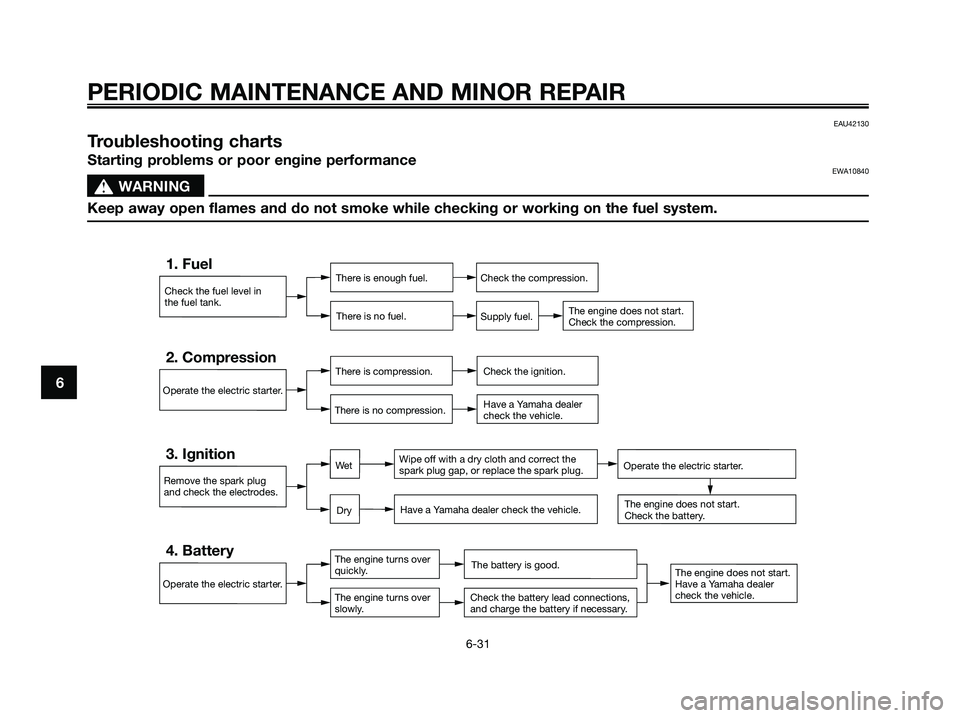
PERIODIC MAINTENANCE AND MINOR REPAIR
6-31
6
EAU42130
Troubleshooting charts
Starting problems or poor engine performanceEWA10840
s s
WARNING
Keep away open flames and do not smoke while checking or working on the fuel system.
Check the fuel level in
the fuel tank.
1. FuelThere is enough fuel.
There is no fuel.Check the compression.
Supply fuel.
The engine does not start.
Check the compression.
Operate the electric starter.
2. CompressionThere is compression.
There is no compression.Check the ignition.
Have a Yamaha dealer
check the vehicle.
Remove the spark plug
and check the electrodes.
3. IgnitionWipe off with a dry cloth and correct the
spark plug gap, or replace the spark plug.
Have a Yamaha dealer check the vehicle.
The engine does not start.
Have a Yamaha dealer
check the vehicle.
The engine does not start.
Check the battery.
Operate the electric starter.
4. BatteryThe engine turns over
quickly.
The engine turns over
slowly.The battery is good.
Check the battery lead connections,
and charge the battery if necessary.
Dry
We tOperate the electric starter.
1C0-F8199-E4.qxd 22/11/07 05:41 Página 72
Page 73 of 88
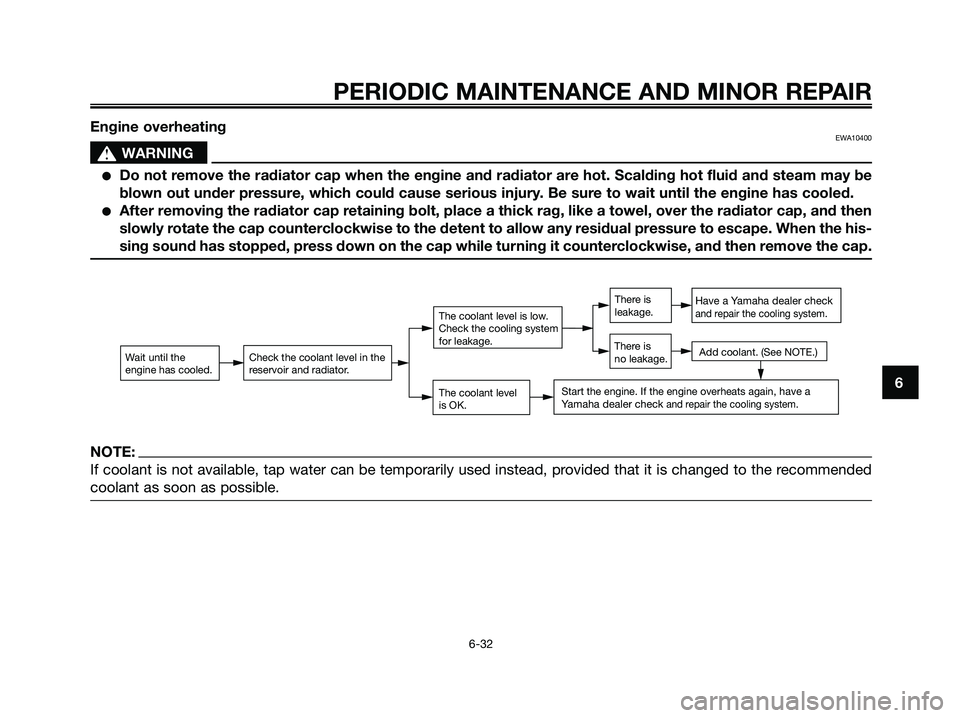
PERIODIC MAINTENANCE AND MINOR REPAIR
6-32
6 Engine overheating
EWA10400
s s
WARNING
●Do not remove the radiator cap when the engine and radiator are hot. Scalding hot fluid and steam may be
blown out under pressure, which could cause serious injury. Be sure to wait until the engine has cooled.
●After removing the radiator cap retaining bolt, place a thick rag, like a towel, over the radiator cap, and then
slowly rotate the cap counterclockwise to the detent to allow any residual pressure to escape. When the his-
sing sound has stopped, press down on the cap while turning it counterclockwise, and then remove the cap.
Wait until the
engine has cooled.Check the coolant level in the
reservoir and radiator.
The coolant level
is OK.
The coolant level is low.
Check the cooling system
for leakage.
Have a Yamaha dealer checkand repair the cooling system.
Add coolant. (See NOTE.)
Start the engine. If the engine overheats again, have a
Yamaha dealer check and repair the cooling system.
There is
leakage.
There is
no leakage.
NOTE:
If coolant is not available, tap water can be temporarily used instead, provided that it is changed to the recommended
coolant as soon as possible.
1C0-F8199-E4.qxd 22/11/07 05:41 Página 73
Page 74 of 88
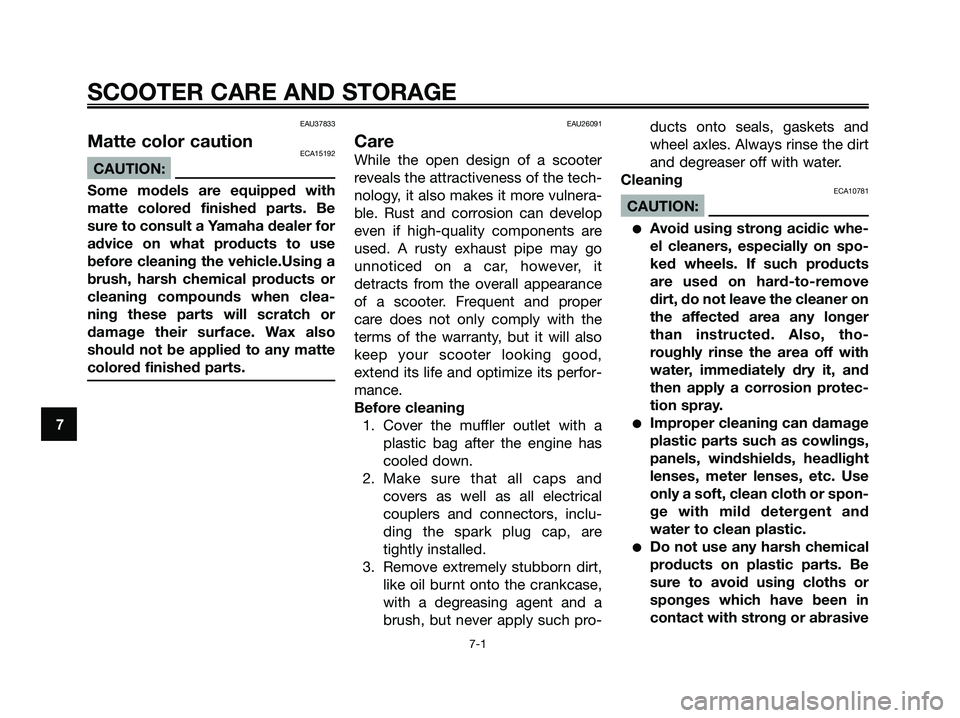
EAU37833
Matte color cautionECA15192
CAUTION:
Some models are equipped with
matte colored finished parts. Be
sure to consult a Yamaha dealer for
advice on what products to use
before cleaning the vehicle.Using a
brush, harsh chemical products or
cleaning compounds when clea-
ning these parts will scratch or
damage their surface. Wax also
should not be applied to any matte
colored finished parts.
EAU26091
Care
While the open design of a scooter
reveals the attractiveness of the tech-
nology, it also makes it more vulnera-
ble. Rust and corrosion can develop
even if high-quality components are
used. A rusty exhaust pipe may go
unnoticed on a car, however, it
detracts from the overall appearance
of a scooter. Frequent and proper
care does not only comply with the
terms of the warranty, but it will also
keep your scooter looking good,
extend its life and optimize its perfor-
mance.
Before cleaning
1. Cover the muffler outlet with a
plastic bag after the engine has
cooled down.
2. Make sure that all caps and
covers as well as all electrical
couplers and connectors, inclu-
ding the spark plug cap, are
tightly installed.
3. Remove extremely stubborn dirt,
like oil burnt onto the crankcase,
with a degreasing agent and a
brush, but never apply such pro-ducts onto seals, gaskets and
wheel axles. Always rinse the dirt
and degreaser off with water.
Cleaning
ECA10781
CAUTION:
●Avoid using strong acidic whe-
el cleaners, especially on spo-
ked wheels. If such products
are used on hard-to-remove
dirt, do not leave the cleaner on
the affected area any longer
than instructed. Also, tho-
roughly rinse the area off with
water, immediately dry it, and
then apply a corrosion protec-
tion spray.
●Improper cleaning can damage
plastic parts such as cowlings,
panels, windshields, headlight
lenses, meter lenses, etc. Use
only a soft, clean cloth or spon-
ge with mild detergent and
water to clean plastic.
●Do not use any harsh chemical
products on plastic parts. Be
sure to avoid using cloths or
sponges which have been in
contact with strong or abrasive
SCOOTER CARE AND STORAGE
7-1
7
1C0-F8199-E4.qxd 22/11/07 05:41 Página 74
Page 75 of 88
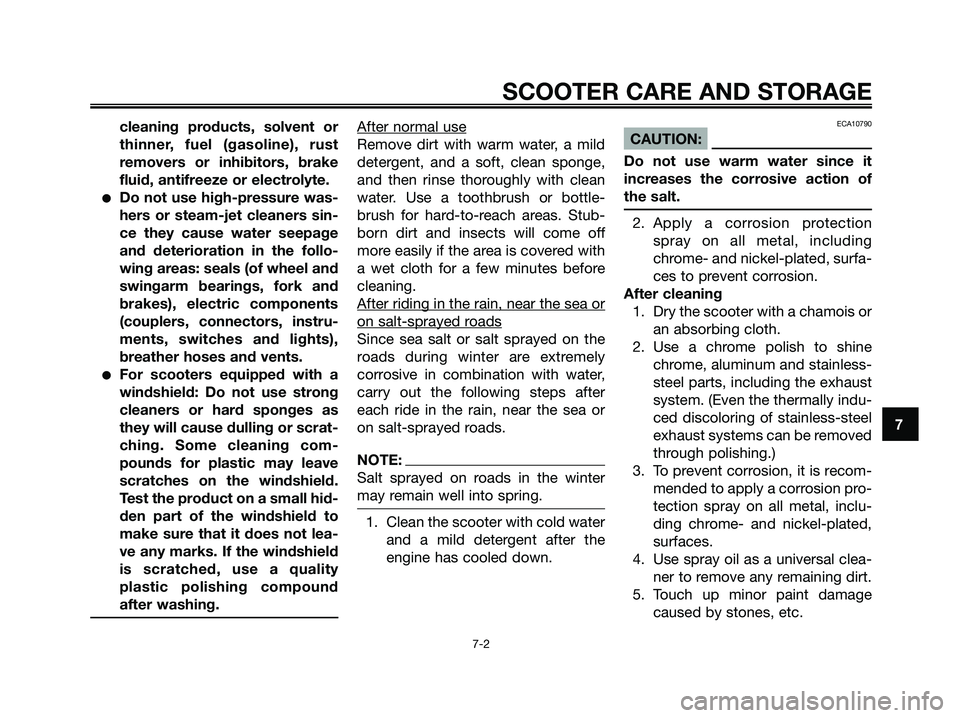
cleaning products, solvent or
thinner, fuel (gasoline), rust
removers or inhibitors, brake
fluid, antifreeze or electrolyte.
●Do not use high-pressure was-
hers or steam-jet cleaners sin-
ce they cause water seepage
and deterioration in the follo-
wing areas: seals (of wheel and
swingarm bearings, fork and
brakes), electric components
(couplers, connectors, instru-
ments, switches and lights),
breather hoses and vents.
●For scooters equipped with a
windshield: Do not use strong
cleaners or hard sponges as
they will cause dulling or scrat-
ching. Some cleaning com-
pounds for plastic may leave
scratches on the windshield.
Test the product on a small hid-
den part of the windshield to
make sure that it does not lea-
ve any marks. If the windshield
is scratched, use a quality
plastic polishing compound
after washing.
After normal use
Remove dirt with warm water, a mild
detergent, and a soft, clean sponge,
and then rinse thoroughly with clean
water. Use a toothbrush or bottle-
brush for hard-to-reach areas. Stub-
born dirt and insects will come off
more easily if the area is covered with
a wet cloth for a few minutes before
cleaning.
After riding in the rain, near the sea or
on salt-sprayed roads
Since sea salt or salt sprayed on the
roads during winter are extremely
corrosive in combination with water,
carry out the following steps after
each ride in the rain, near the sea or
on salt-sprayed roads.
NOTE:
Salt sprayed on roads in the winter
may remain well into spring.
1. Clean the scooter with cold water
and a mild detergent after the
engine has cooled down.
ECA10790
CAUTION:
Do not use warm water since it
increases the corrosive action of
the salt.
2. Apply a corrosion protection
spray on all metal, including
chrome- and nickel-plated, surfa-
ces to prevent corrosion.
After cleaning
1. Dry the scooter with a chamois or
an absorbing cloth.
2. Use a chrome polish to shine
chrome, aluminum and stainless-
steel parts, including the exhaust
system. (Even the thermally indu-
ced discoloring of stainless-steel
exhaust systems can be removed
through polishing.)
3. To prevent corrosion, it is recom-
mended to apply a corrosion pro-
tection spray on all metal, inclu-
ding chrome- and nickel-plated,
surfaces.
4. Use spray oil as a universal clea-
ner to remove any remaining dirt.
5. Touch up minor paint damage
caused by stones, etc.
SCOOTER CARE AND STORAGE
7-2
7
1C0-F8199-E4.qxd 22/11/07 05:41 Página 75
Page 76 of 88
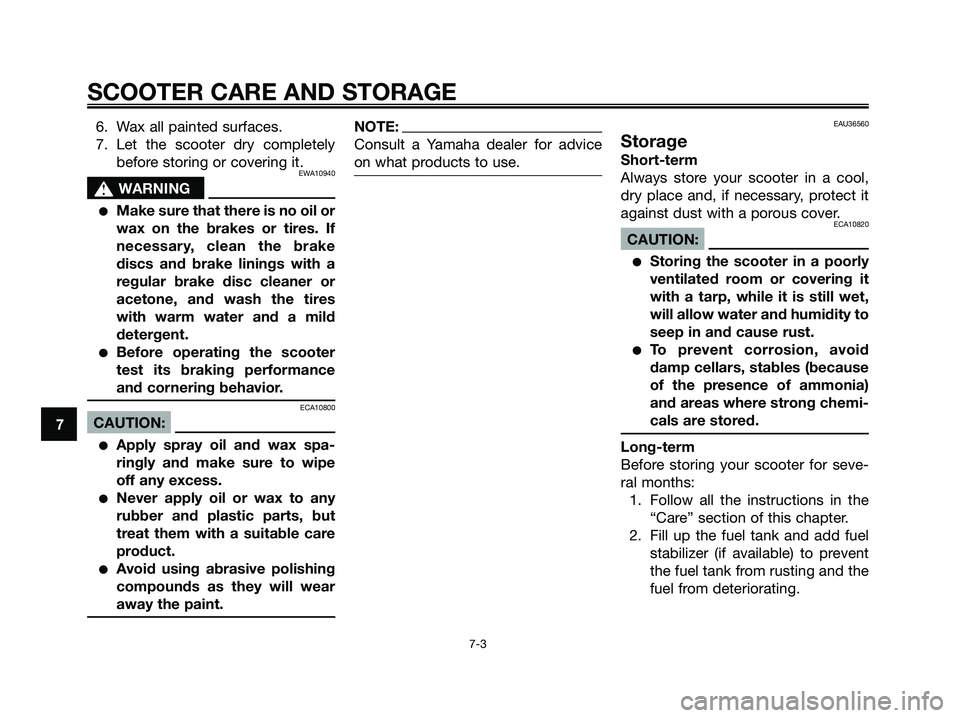
6. Wax all painted surfaces.
7. Let the scooter dry completely
before storing or covering it.
EWA10940
s s
WARNING
●Make sure that there is no oil or
wax on the brakes or tires. If
necessary, clean the brake
discs and brake linings with a
regular brake disc cleaner or
acetone, and wash the tires
with warm water and a mild
detergent.
●Before operating the scooter
test its braking performance
and cornering behavior.
ECA10800
CAUTION:
●Apply spray oil and wax spa-
ringly and make sure to wipe
off any excess.
●Never apply oil or wax to any
rubber and plastic parts, but
treat them with a suitable care
product.
●Avoid using abrasive polishing
compounds as they will wear
away the paint.
NOTE:
Consult a Yamaha dealer for advice
on what products to use.EAU36560
Storage
Short-term
Always store your scooter in a cool,
dry place and, if necessary, protect it
against dust with a porous cover.
ECA10820
CAUTION:
●Storing the scooter in a poorly
ventilated room or covering it
with a tarp, while it is still wet,
will allow water and humidity to
seep in and cause rust.
●To prevent corrosion, avoid
damp cellars, stables (because
of the presence of ammonia)
and areas where strong chemi-
cals are stored.
Long-term
Before storing your scooter for seve-
ral months:
1. Follow all the instructions in the
“Care” section of this chapter.
2. Fill up the fuel tank and add fuel
stabilizer (if available) to prevent
the fuel tank from rusting and the
fuel from deteriorating.
SCOOTER CARE AND STORAGE
7-3
7
1C0-F8199-E4.qxd 22/11/07 05:41 Página 76
Page 77 of 88
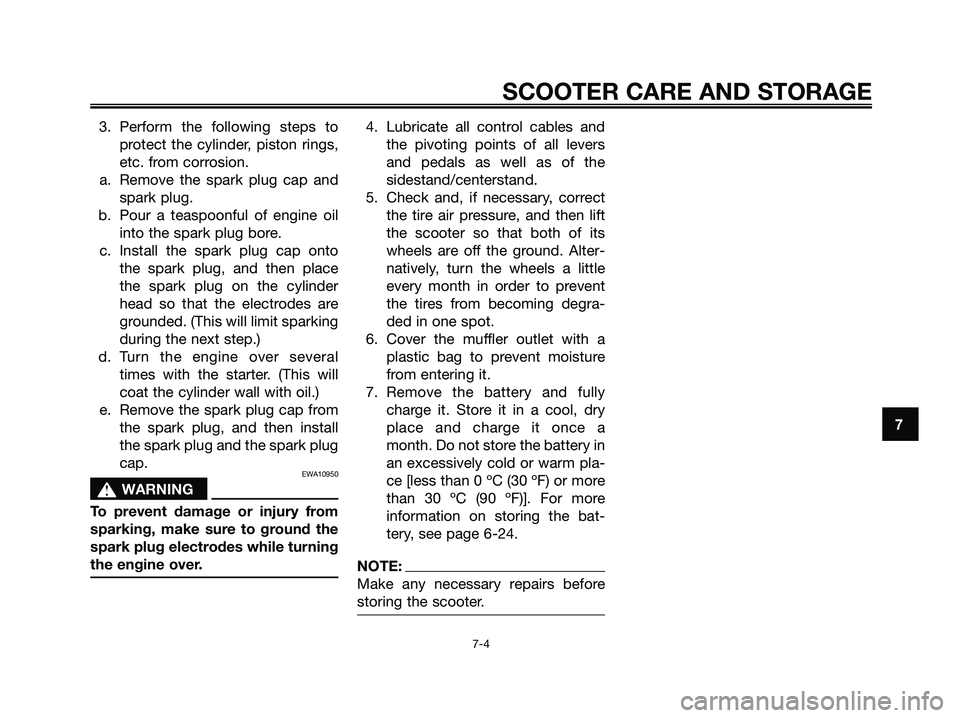
3. Perform the following steps to
protect the cylinder, piston rings,
etc. from corrosion.
a. Remove the spark plug cap and
spark plug.
b. Pour a teaspoonful of engine oil
into the spark plug bore.
c. Install the spark plug cap onto
the spark plug, and then place
the spark plug on the cylinder
head so that the electrodes are
grounded. (This will limit sparking
during the next step.)
d. Turn the engine over several
times with the starter. (This will
coat the cylinder wall with oil.)
e. Remove the spark plug cap from
the spark plug, and then install
the spark plug and the spark plug
cap.
EWA10950
s s
WARNING
To prevent damage or injury from
sparking, make sure to ground the
spark plug electrodes while turning
the engine over.
4. Lubricate all control cables and
the pivoting points of all levers
and pedals as well as of the
sidestand/centerstand.
5. Check and, if necessary, correct
the tire air pressure, and then lift
the scooter so that both of its
wheels are off the ground. Alter-
natively, turn the wheels a little
every month in order to prevent
the tires from becoming degra-
ded in one spot.
6. Cover the muffler outlet with a
plastic bag to prevent moisture
from entering it.
7. Remove the battery and fully
charge it. Store it in a cool, dry
place and charge it once a
month. Do not store the battery in
an excessively cold or warm pla-
ce [less than 0 ºC (30 ºF) or more
than 30 ºC (90 ºF)]. For more
information on storing the bat-
tery, see page 6-24.
NOTE:
Make any necessary repairs before
storing the scooter.
SCOOTER CARE AND STORAGE
7-4
7
1C0-F8199-E4.qxd 22/11/07 05:41 Página 77
Page 78 of 88
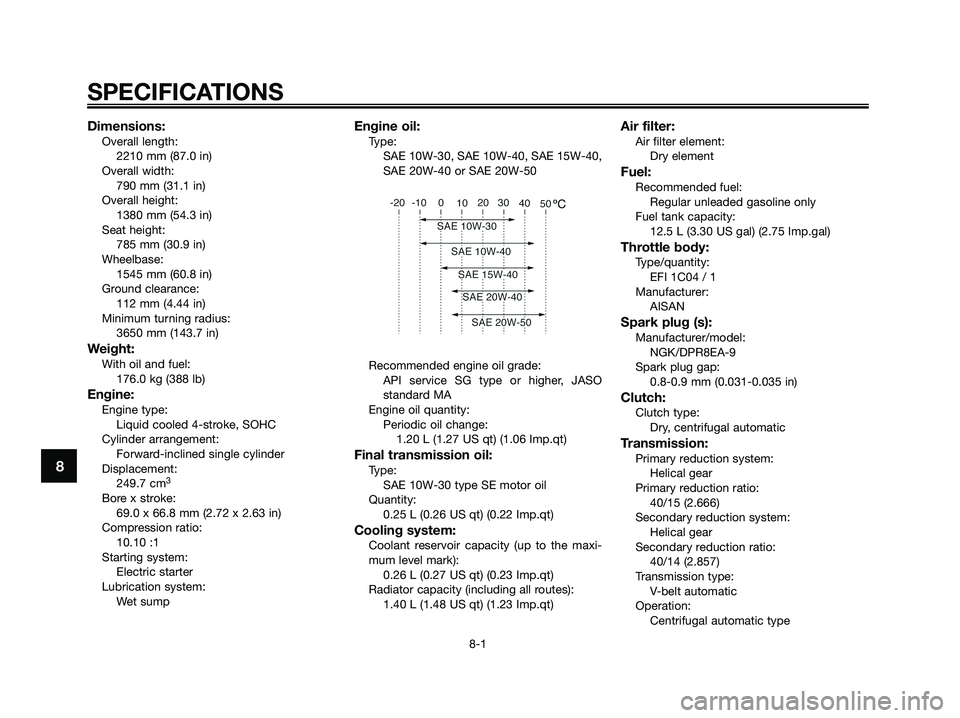
Dimensions:Overall length:
2210 mm (87.0 in)
Overall width:
790 mm (31.1 in)
Overall height:
1380 mm (54.3 in)
Seat height:
785 mm (30.9 in)
Wheelbase:
1545 mm (60.8 in)
Ground clearance:
112 mm (4.44 in)
Minimum turning radius:
3650 mm (143.7 in)
Weight:With oil and fuel:
176.0 kg (388 lb)
Engine:Engine type:
Liquid cooled 4-stroke, SOHC
Cylinder arrangement:
Forward-inclined single cylinder
Displacement:
249.7 cm
3
Bore x stroke:
69.0 x 66.8 mm (2.72 x 2.63 in)
Compression ratio:
10.10 :1
Starting system:
Electric starter
Lubrication system:
Wet sump
Engine oil:Type:
SAE 10W-30, SAE 10W-40, SAE 15W-40,
SAE 20W-40 or SAE 20W-50
Recommended engine oil grade:
API service SG type or higher, JASO
standard MA
Engine oil quantity:
Periodic oil change:
1.20 L (1.27 US qt) (1.06 Imp.qt)
Final transmission oil:Type:
SAE 10W-30 type SE motor oil
Quantity:
0.25 L (0.26 US qt) (0.22 Imp.qt)
Cooling system:Coolant reservoir capacity (up to the maxi-
mum level mark):
0.26 L (0.27 US qt) (0.23 Imp.qt)
Radiator capacity (including all routes):
1.40 L (1.48 US qt) (1.23 Imp.qt)
Air filter:Air filter element:
Dry element
Fuel:Recommended fuel:
Regular unleaded gasoline only
Fuel tank capacity:
12.5 L (3.30 US gal) (2.75 Imp.gal)
Throttle body:Type/quantity:
EFI 1C04 / 1
Manufacturer:
AISAN
Spark plug (s):Manufacturer/model:
NGK/DPR8EA-9
Spark plug gap:
0.8-0.9 mm (0.031-0.035 in)
Clutch:Clutch type:
Dry, centrifugal automatic
Transmission:Primary reduction system:
Helical gear
Primary reduction ratio:
40/15 (2.666)
Secondary reduction system:
Helical gear
Secondary reduction ratio:
40/14 (2.857)
Transmission type:
V-belt automatic
Operation:
Centrifugal automatic type
SPECIFICATIONS
8-1
8
1C0-F8199-E4.qxd 22/11/07 05:41 Página 78
Page 79 of 88
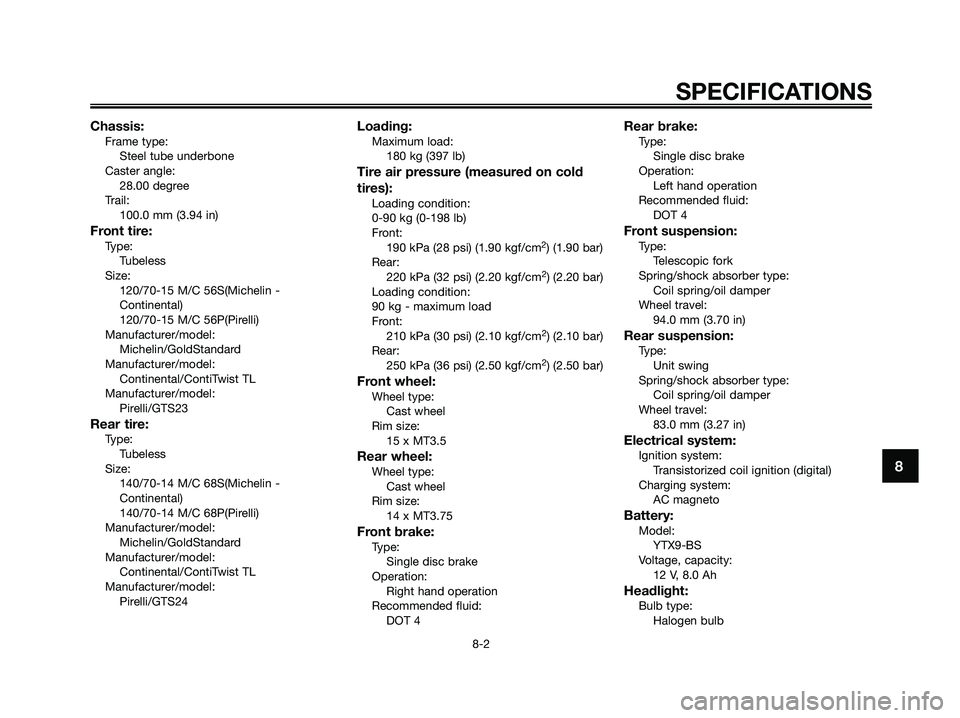
Chassis:Frame type:
Steel tube underbone
Caster angle:
28.00 degree
Trail:
100.0 mm (3.94 in)
Front tire:Type:
Tubeless
Size:
120/70-15 M/C 56S(Michelin -
Continental)
120/70-15 M/C 56P(Pirelli)
Manufacturer/model:
Michelin/GoldStandard
Manufacturer/model:
Continental/ContiTwist TL
Manufacturer/model:
Pirelli/GTS23
Rear tire:Type:
Tubeless
Size:
140/70-14 M/C 68S(Michelin -
Continental)
140/70-14 M/C 68P(Pirelli)
Manufacturer/model:
Michelin/GoldStandard
Manufacturer/model:
Continental/ContiTwist TL
Manufacturer/model:
Pirelli/GTS24
Loading:Maximum load:
180 kg (397 lb)
Tire air pressure (measured on cold
tires):
Loading condition:
0-90 kg (0-198 lb)
Front:
190 kPa (28 psi) (1.90 kgf/cm
2) (1.90 bar)
Rear:
220 kPa (32 psi) (2.20 kgf/cm
2) (2.20 bar)
Loading condition:
90 kg - maximum load
Front:
210 kPa (30 psi) (2.10 kgf/cm
2) (2.10 bar)
Rear:
250 kPa (36 psi) (2.50 kgf/cm
2) (2.50 bar)
Front wheel:Wheel type:
Cast wheel
Rim size:
15 x MT3.5
Rear wheel:Wheel type:
Cast wheel
Rim size:
14 x MT3.75
Front brake:Type:
Single disc brake
Operation:
Right hand operation
Recommended fluid:
DOT 4
Rear brake:Type:
Single disc brake
Operation:
Left hand operation
Recommended fluid:
DOT 4
Front suspension:Type:
Telescopic fork
Spring/shock absorber type:
Coil spring/oil damper
Wheel travel:
94.0 mm (3.70 in)
Rear suspension:Type:
Unit swing
Spring/shock absorber type:
Coil spring/oil damper
Wheel travel:
83.0 mm (3.27 in)
Electrical system:Ignition system:
Transistorized coil ignition (digital)
Charging system:
AC magneto
Battery:Model:
YTX9-BS
Voltage, capacity:
12 V, 8.0 Ah
Headlight:Bulb type:
Halogen bulb
SPECIFICATIONS
8-2
8
1C0-F8199-E4.qxd 22/11/07 05:41 Página 79
Page 80 of 88
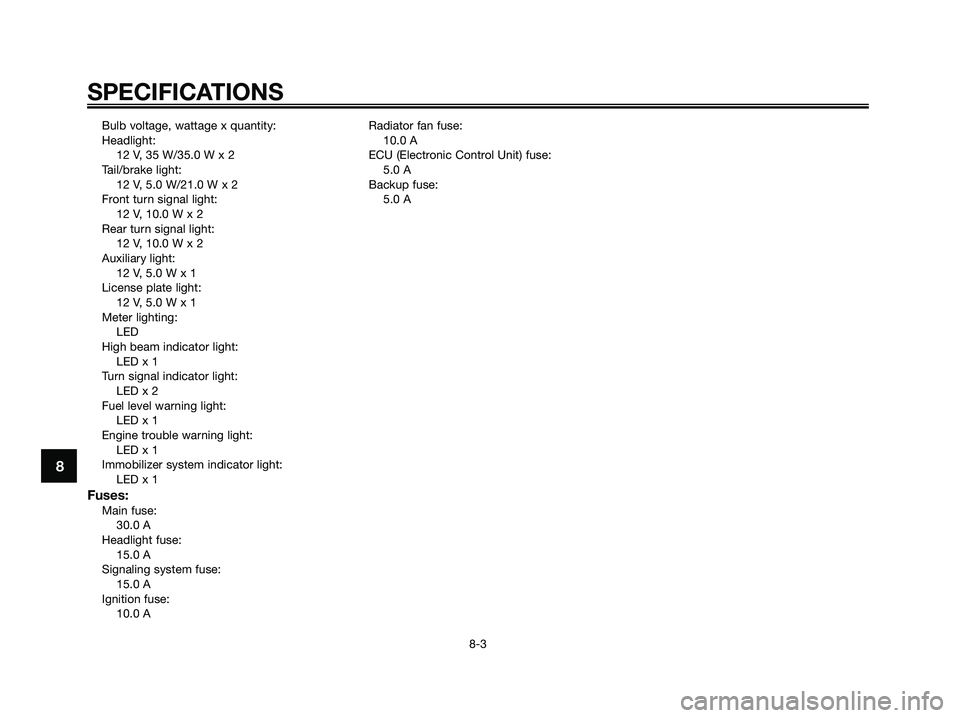
Bulb voltage, wattage x quantity:
Headlight:
12 V, 35 W/35.0 W x 2
Tail/brake light:
12 V, 5.0 W/21.0 W x 2
Front turn signal light:
12 V, 10.0 W x 2
Rear turn signal light:
12 V, 10.0 W x 2
Auxiliary light:
12 V, 5.0 W x 1
License plate light:
12 V, 5.0 W x 1
Meter lighting:
LED
High beam indicator light:
LED x 1
Turn signal indicator light:
LED x 2
Fuel level warning light:
LED x 1
Engine trouble warning light:
LED x 1
Immobilizer system indicator light:
LED x 1
Fuses:Main fuse:
30.0 A
Headlight fuse:
15.0 A
Signaling system fuse:
15.0 A
Ignition fuse:
10.0 ARadiator fan fuse:
10.0 A
ECU (Electronic Control Unit) fuse:
5.0 A
Backup fuse:
5.0 A
SPECIFICATIONS
8-3
8
1C0-F8199-E4.qxd 22/11/07 05:41 Página 80